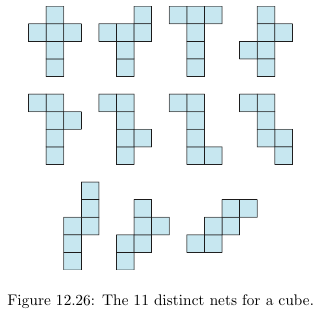Two students in my class asked and answered what might be a novel question. It is well known that the cube has exactly $11$ edge-unfoldings (or "nets"), as shown below:

(Image from this MO posting.)
It is also well known that each of the eleven can tile the plane, i.e., form a monohedral tiling. The students, Elsa Bieger and Heather Robertson, asked: Can the $11$ unfoldings be edge-to-edge glued together, each used exactly once, to form a supertile that can then tile the plane monohedrally? They found four supertiles:
and here's how each supertile fits together with copies of itself:
So in the spirt of the earlier MO question, Which unfoldings of the hypercube tile 3-space, which led to Moritz Firsching showing that all hypercube unfoldings can (individually) tile space, it is natural to ask:
Q. Can the $261$ unfoldings of the hypercube be face-to-face glued together, each used exactly once, to form a supertile that can then tile $3$-space monohedrally?


